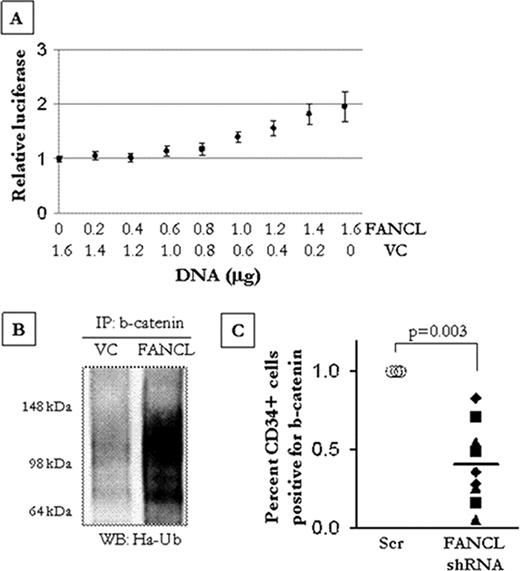Abstract
Abstract 1335
Fanconi anemia (FA) is associated with a hereditary predisposition to bone marrow failure. The proteins encoded by the FANC genes are primarily involved in DNA repair responses through the formation of a large, multisubunit complex that has E3 ubiquitin ligase activity (Annual Review of Genetics 2009;43:223). FA hematopoietic stem cells display defective stem cell properties and limited replicative potential. However, the molecular basis for how a FA genetic background contributes to those defects remains poorly understood. Here we provide evidence that FANCL, which has E3 ubiquitin ligase activity, enhances beta-catenin activity (Figure A) and protein expression. Beta-catenin is a nuclear effector of canonical Wnt signaling. The Wnt/beta-catenin pathway is active in normal hematopoietic stem cells in the native bone marrow environment and disruption of this signaling pathway results in defective hematopoietic stem cells (Nature 2003;423:409). To test whether FANCL positively regulates beta-catenin through its ubiquitination activity, we performed cell-based ubiquitination assays. We show that FANCL functionally ubiquitinates beta-catenin (Figure B) and that ubiquitin chain extension can occur via non-lysine-48 ubiquitin linkages. Accumulating evidence reveal diverse, non-proteolytic biological roles for proteins modified by atypical ubiquitin chains (EMBO Reports 2008;9:536). Our data suggests that FANCL may enhance the protein function of beta-catenin via ubiquitination with atypical ubiquitin chains. Importantly, we demonstrate that suppression of FANCL expression in human CD34+ cord blood stem cells reduces beta-catenin expression (Figure C) and multilineage progenitor expansion. These results demonstrate a role for the FA pathway in regulating Wnt/beta-catenin signaling. Therefore, diminished Wnt/beta-catenin signaling may be an important underlying molecular defect in FA hematopoietic stem cells leading to their accelerated loss.
A, LEF-TCF-luciferase reporter assay showing increasing beta-catenin activity in 293FT cells with increasing FANCL expression compared with vector-control (VC) (n=4). B, Immunoprecipitation of beta-catenin in cells transfected with vector-control or FANCL and probed for hemagglutinin (HA)-tagged ubiquitin shows increased ubiquitinated forms of beta-catenin with FANCL expression (n=4). C, shRNA suppression of FANCL expression in CD34+ cord blood stem cells results in decreased beta-catenin expression compared with a scramble control (Scr) by immunofluorescence analysis (three different shRNA constructs, n=3 for each construct).
Disclosures:
No relevant conflicts of interest to declare.
Author notes
*
Asterisk with author names denotes non-ASH members.
© 2011 by The American Society of Hematology
2011


This feature is available to Subscribers Only
Sign In or Create an Account Close Modal